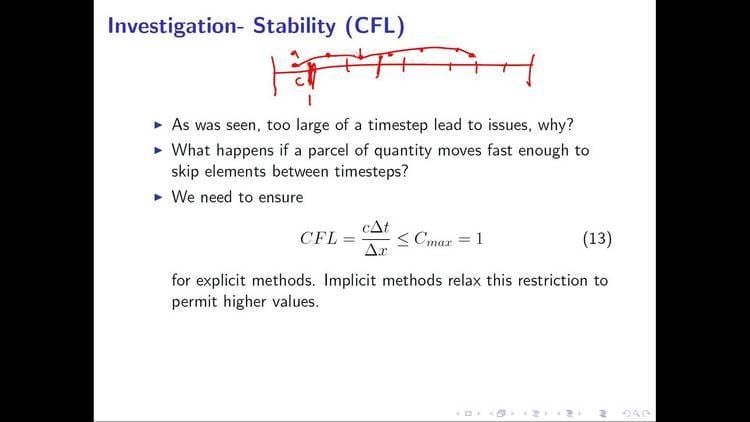 | ||
In mathematics, the Courant–Friedrichs–Lewy (CFL) condition is a necessary condition for convergence while solving certain partial differential equations (usually hyperbolic PDEs) numerically by the method of finite differences. It arises in the numerical analysis of explicit time integration schemes, when these are used for the numerical solution. As a consequence, the time step must be less than a certain time in many explicit time-marching computer simulations, otherwise the simulation will produce incorrect results. The condition is named after Richard Courant, Kurt Friedrichs, and Hans Lewy who described it in their 1928 paper.
Contents
Heuristic description
The principle behind the condition is that, for example, if a wave is moving across a discrete spatial grid and we want to compute its amplitude at discrete time steps of equal duration, then this duration must be less than the time for the wave to travel to adjacent grid points. As a corollary, when the grid point separation is reduced, the upper limit for the time step also decreases. In essence, the numerical domain of dependence of any point in space and time (as determined by initial conditions and the parameters of the approximation scheme) must include the analytical domain of dependence (wherein the initial conditions have an effect on the exact value of the solution at that point) in order to assure that the scheme can access the information required to form the solution.
The CFL condition
In order to make a reasonably formally precise statement of the condition, it is necessary to define the following quantities
The spatial coordinates and the time are supposed to be discrete-valued independent variables, which are placed at regular distances called the interval length and the time step, respectively. Using these names, the CFL condition relates the length of the time step to a function of the interval lengths of each spatial coordinate and of the maximum speed with which information can travel in the physical space.
Operatively, the CFL condition is commonly prescribed for those terms of the finite-difference approximation of general partial differential equations which model the advection phenomenon.
The one-dimensional case
For one-dimensional case, the CFL has the following form:
where the dimensionless number is called the Courant number,
The value of
The two and general n-dimensional case
In the two-dimensional case, the CFL condition becomes
with obvious meaning of the symbols involved. By analogy with the two-dimensional case, the general CFL condition for the
The interval length is not required to be the same for each spatial variable
The CFL condition is only a necessary one
The CFL condition is a necessary condition, but may not be sufficient for the convergence of the finite-difference approximation of a given numerical problem. Thus, in order to establish the convergence of the finite-difference approximation, it is necessary to use other methods, which in turn could imply further limitations on the length of the time step and/or the lengths of the spatial intervals.
